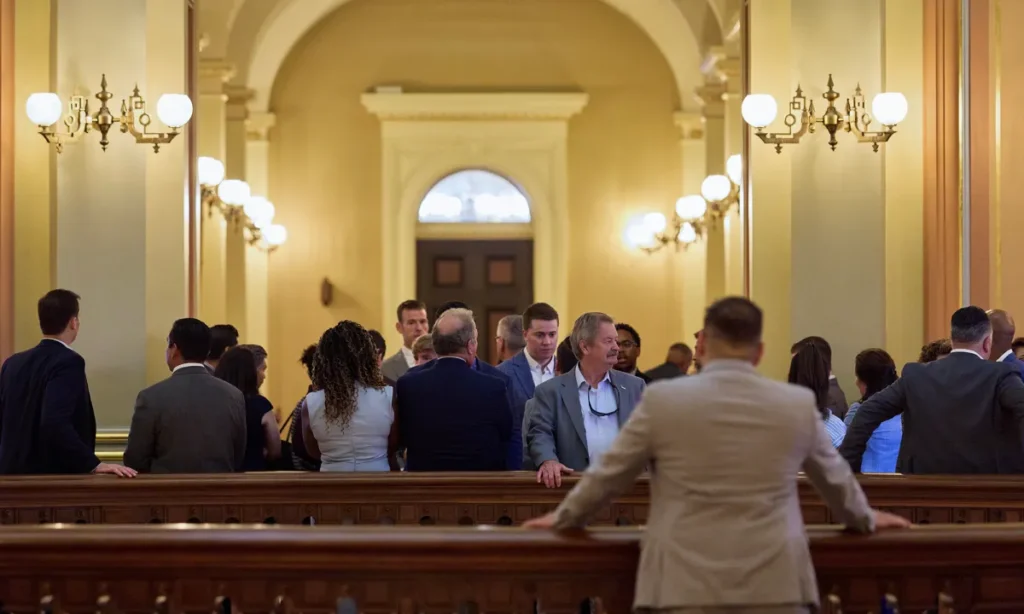Woolf Farming was an early adopter of leasing farmland for solar facilities in western Fresno County. (GV Wire/Jahz Tello)

- A massive solar generation, storage, and transmission project on the west side of Fresno County called the Valley Clean Infrastructure Plan could generate as much as 20,000 megawatts.
- The project would provide much-needed solar electricity for California, new revenue streams for farmers and growers as water supplies diminish, and new job opportunities for farmworkers.
- Advocate say California will need projects like VCIP to meet its future zero-carbon goals.
Share
|
Getting your Trinity Audio player ready...
|
HURON — A wide band of sun-baked land running along the Interstate 5 corridor in western Fresno County is the proposed site for a large-scale solar farming, electricity storage, and transmission project that could produce as much as 20,000 megawatts of solar-generated electricity — enough for nine million homes.
Proponents say the Valley Clean Infrastructure Plan would provide the infrastructure, including five new substations and high-voltage lines that would be needed to move that much power onto California’s electrical grid, in addition to the master-planning of up to 130,000 acres owned by Westlands Water District or held privately by farmers.
That’s nearly double the size of the city of Fresno’s footprint.
It would dwarf the solar generation facilities now operating in the region. One of the largest is Westlands Solar Park in Kings County, right next to the Fresno County line and just southwest of Lemoore. It covers 20,000 acres and produces about 1,170 megawatts with a capacity of 2,700 megawatts. By contrast, Fresno County’s largest solar farms straddle Highway 33 northwest of Cantua Creek and combine for nearly 3,000 acres and more than 400 megawatts, according to the U.S. Solar Photovoltaic Database.
Want to know where solar farms are located in the Valley and around the state? Check out the U.S. Solar Photovoltaic Database
Ground Zero for California Solar
The westside of the Central Valley has been identified as a key location for solar energy generation plants, for several important reasons. It’s near the center of the state and existing transmission lines. Farmers and growers are facing a water crisis brought on by restrictions on groundwater pumping combined with decreases in surface water allocations and are in need of new revenue streams. And the same sunshine that has made the Central Valley one of the world’s most productive farm belts can be harvested as electricity.
Solar farming gives new use to land that has been fallowed either because it is drainage impaired or because of a lack of water pumped from the ground or shipped from Northern California through the state’s aqueducts.
In addition to providing a new source of revenue for farmers, the massive amount of solar energy and storage that the VCIP project proposes would move California closer to meeting its mandated goal of carbon-free energy generation by 2045.
While VCIP’s potential output of 20,000 megawatts might be enough for nine million homes today, in the future Californians will need even more electricity to power their vehicles and their home HVACs and appliances like water heaters and stoves as the state goes all-electric.
Clearly, future Californians will need much more solar-generated electricity, and projects like VCIP will be “critical,” says Shannon Eddy, executive director of the Large-scale Solar Association, an advocacy organization for utility-scale solar developments that’s based in California. Eddy notes that she’s heard of only one other 20,000-megawatt project starting up, and it’s in China.
California’s zero-carbon future rides on getting projects like VCIP up and running, Eddy said.
“And not just this one, but really all the utility-scale solar projects are needed,” she said. ” … We need to learn how to say yes to these projects.”
Related Story: California Sides With Big Utilities, Trim Incentives for Community Solar ...
California’s Growing Solar Needs
VCIP is being spearheaded by Golden State Clean Energy, a privately held, California-based and California-led infrastructure development company, in partnership with the Westlands Water District. Golden State’s principals were involved in developing the Westlands Solar Park in Kings County.
A 2021 study by the California Energy Commission, California Public Utilities Commission, and the California Independent System Operator estimated that the state would need 170,000 to 200,000 megawatts of new solar generation and battery storage to meet its energy needs by 2045, said Patrick Mealoy, a partner and chief operating officer for Golden State Clean Energy.
Projects like VCIP are needed to produce that much solar-generated electricity, Mealoy said.
“We represent an opportunity of being somewhere between 10 to upper-teens percent of what California would need between today and 2045,” he said.
An October 2022 report by the Public Policy Institute of California said that the San Joaquin Valley has “some of the best solar development prospects in the state,” in part because the region is faced with meeting the requirements of the Sustainable Groundwater Management Act that sets limits on groundwater pumping.
Some landowners, regardless of water availability, already have realized that solar developments will pay them anywhere from $1,000 to $15,000 per acre annually, depending on whether it’s for an annual lease or long-term options for purchase or an easement. That’s compared to the $200 to $450 per acre per year they earn now for annual crops, the PPIC report said. Just to hold land in options for potential solar development can net them a few hundred dollars per acre yearly, the report said.

More Transmission Needed
But the increasing number of utility-scale solar developments will need a correspondingly large increase in transmission facilities. Developers and agencies will need to identify the sites and complete the permitting process “very soon” if California is to stay on track to meeting its clean energy targets, the PPIC reported.
There also will need to be increased coordination and planning integration between developers, communities, and local and state agencies with oversight responsibilities. Development permitting will need to be simplified, and state energy planning processes should become “less reactive and more proactive, in particular when it comes to understanding local land use constraints and opportunities,” the PPIC report said.
Because transmission is time-intensive to plan and permit and expensive to build, projects like VCIP need to be massive to generate enough solar-generated power to make the necessary infrastructure improvements economically feasible, Mealoy says.
“There’s been a lot of projects that were proposed, and most of them have failed, in the San Joaquin Valley because of the constraints on the transmission system. So one of the real drivers around VCIP is, we are big enough, that we can withstand the cost and long lead time necessary to build that transmission infrastructure,” he said.
When asked about the estimated cost of the project Mealoy is somewhat vague, only saying that it will be in the “tens of billions” of dollars based on current infrastructure costs.
Golden State is self-funding its related work on the project, he said.
Improving Transmission Flows
VCIP’s lines will alleviate congestion that now exists on two major transmission lines connecting Northern and Southern California, Mealoy said.
Central California, where the resources of Pacific Gas and Electric and Southern California Edison meet, is home to the most congested and constrained paths in the entire western U.S., he said.
“This project’s footprint literally straddles Path 15, which is the pinch point between flows between Northern and Southern California. So we are literally talking about doing build-out of resources and then new wires to help alleviate constraint,” Mealoy said. “There’s probably not a better spot to do a large scale, from a transmission engineering perspective. If you’re going to put a large amount of resources, you want to put it in a spot where you can flow it (electricity) in as many directions as possible to meet consumers’ needs.”
Although the infrastructure will be permanent, the land that VCIP’s contractors will need for solar generation sites will be leased over 30 years or so. So in the future if water supplies increase and if solar power generation technology improves and requires less acreage to produce equal or greater amounts of power, the land might be returned to agricultural production.

New Revenue Option for Landowners
Solar projects like VCIP will give westside farmers a new and much-needed revenue stream, and also allow them to channel their limited water resources from the fallowed land leased for solar farming to land they can still use for growing crops, said Ryan Jacobsen, CEO of the Fresno County Farm Bureau.
Jacobsen said he’s spoken to farmers whose land might be candidates for solar farming. “Every single farmer … they want to farm that ground. It’s just that the realities of the lack of reliable water supply is really hampering them from doing that,” he said. “And they know that’s most likely not going to get a whole lot better over the course of the next couple of decades.”
Even though Northern California’s dams are holding big water supplied by a wet winter, westside farmers have been told to prepare to receive only 40% of their full allocation, Jacobsen said. (The Bureau of Reclamation announced last Wednesday that the allocation for south of the Delta has been increased to 50%.) And the tightening restrictions on using groundwater resulting from SGMA are cutting into water supplies as well.
Susan Byers, whose family grows almonds on the westside of the Valley, didn’t know what to make of the VCIP project or its backers when she first heard of it. She asked questions, did some research, gathered information, and what she heard helped convince her that VCIP was a good option for Valley farmers and growers who, facing decreased water supplies, will need a new income source.
“I think what was appealing to me about this was the scope of the project, and their very diligent sort of master planning approach,” she said. “I am no expert by any means in solar or how everything works, but it did suggest the level of understanding and commitment and I think investment on their part. There’s a long road to making this successful, and it does seem like they’re certainly willing to do it.”

Early Adopters of Solar Farm Leasing
Stuart Woolf, president of Woolf Farming Co. that’s a major farming operation on the Valley’s westside, says some Woolf land might wind up leased through VCIP. That would be in addition to the 1,200 acres just south of Woolf Farming’s headquarters on Gale Avenue south of Huron that started to be converted a decade ago to a solar farm with panels, storage batteries, and a connection to the nearby Gates substation.
The plant went into full operation within the past year and can produce 40 megawatts.
Long before VCIP was a blip on the Westlands radar, Woolf Farming saw that future water supplies would become more limited and that the farming operation would need options on how to generate revenue from the land.
But it wasn’t an easy or quick process, and the battle was fought on several fronts, Woolf said. He needed to convince the Fresno County Board of Supervisors to issue a Williamson Act waiver to allow solar farming on ag land, and also to convince Westlands Water District to allow Woolf to maintain its water rights, both surface and groundwater, for the parcels that would farm the sun instead of fruits and vegetables.
It took five years to convince the county supevisors that Woolf planned to continue agricultural commodity farming but should be allowed the waiver to lease some land for solar, he said: “We made the pitch that we look at it as another crop.”
The Williamson Act provides property tax relief to owners of farmland and open-space land in exchange for agreeing that the land will not be developed or converted to another use. Landowners who want out of their Williamson Act contracts may be subject to a cancellation valuation of 12.5%.
Keeping Water Rights
Convincing Westlands that Woolf Farming should retain its water rights took an extra year. Woolf said he had to overcome the argument from some board members that the ranch enjoys proximity to an existing substation and power lines that other farmers don’t have.
Board members told him, “It’s not fair that you get to get income from a solar project and then keep your water.”
“And the thing is, if you took the water on like a 1,200-acre parcel and you spread it throughout the district, the 600,000-acre district, most growers wouldn’t even know they got any water,” he said. “I mean, it’s divided so much over so many acres that it’s next to nothing.”
Using the retained water rights, Woolf can now direct water to other parcels and boost supplies in those fields.
But even that isn’t a complete replacement for the reduced allocations through the federal water contracts and limits on groundwater pumping required by SGMA, said Rick Blankenship, Woolf’s vice president of farming.
“Keeping the surface and our pump allocation does not allow us to farm 100% of the acre. We’re still having to fallow land,” he said.
Woolf said that farmers whose land is distant from the existing power grid infrastructure will be able to reap the benefits of solar farming and the infrastructure connections that VCIP will provide.
Solar Projects Generate Jobs
VCIP also will generate new jobs, especially for electrical and construction workers. It’s expected to create on average 3,000 construction jobs for at least 10 years and approximately 500 permanent jobs.
Golden State has entered into project-labor agreements for the transmission and batteries projects that it builds and has already had conversations with local representatives of the International Brotherhood of Electrical Workers and westside communities about creating job training opportunities, Mealoy said.
The 2022 PPIC report acknowledged that a portion of lost agricultural jobs might be replaced by solar workforce jobs, and there could be steady work over the decades as new projects are phased in. But the report cautioned that training programs will need to be tailored to help overcome the challenges of language barriers, a lack of transportation, lost wages, and family obligations.
There’s already a role model for how solar projects can create local jobs. The PPIC report said that the Westlands Solar Park’s first utility-scale solar project consistently employed about 350 on-site workers, most of whom were from the Valley.
“Many project installers were also first-time workers in renewables, a testament to effective coordination between project developers and workforce training efforts,” the report said.
It will be some time yet before VCIP will start hiring. The project is only about 18 months into what Mealoy estimates will be a 10- to 12-year time frame for build-out. Documents are being prepared for the draft environmental impact report that will be required under the California Environmental Quality Act, or CEQA. Some critters could be impacted by the project, but for the most part the fallowed and drainage-impaired farmland is already considered disturbed habitat and less likely to face challenges.
Westlands is conducting the environmental review for VCIP, and scoping meetings were held in February online and in person at Westlands’ district office and the Cantua Creek Elementary School, deputy general manager Elizabeth Jonasson Rosas said.
She said she expects the draft Programmatic Environmental Impact Report by the end of this year.

Assembly Bill Targets Westlands Solar
On June 11, Jonasson Rosas appeared alongside Assemblymember Esmeralda Soria and Marc Joseph, representing the Coalition of California Utility Employees, to provide testimony to the Senate Local Government Committee about Assembly Bill 2661, which Soria sponsored. AB 2661 would authorize Westlands to construct solar facilities, including battery storage, and build, own, and operate transmission lines to convey solar-generated electricity to the grid.
Earlier versions of the bill would have provided the same solar-power generation authorization to all water districts statewide. It also would have required the California Public Utilities Commission to conduct a “sensitivity analysis” on the potential for 10,000 to 30,000 megawatts of additional solar electrical generation and then provide that analysis to the California Independent Systems Operator for its transmission planning process.
Jonasson Rosas, Soria, and Joseph testified about the bill’s potential to help California meet its clean energy goals as well as produce new jobs in a region where dwindling water supplies are causing massive job losses.
“As someone that represents the Central Valley, I know that this can be a game-changer for our community,” Soria said. “We can help meet the climate goals of the state, but at the same time uplift the communities that have been left behind for generations.”
Joseph emphasized that the transmission facilities would still need the PUC’s determination that they would be cost-effective and “a good deal for ratepayers.”
Mealoy said that if AB 2661 is signed into law, it will benefit VCIP by shedding light on the project as an example of what might be built in California, but he said its passage isn’t critical to VCIP moving forward.
AB 2661 is scheduled for a hearing on Tuesday, July 2, before the Senate Committee on Energy, Utilities, and Communications.
Need to Find a Common Goal
If California is going to meet its energy production goals, Eddy of the Large-scale Solar Association said the state will need the same sense of urgency, teamwork, drive, and shared purpose that Americans mustered during World War II.
“Are we willing to do what it takes? I was really struck by the D-Day anniversary. CBS had the interview, and you probably saw this, the guys that were actually on the ground on D-Day, they’re still alive and they’re spry and they’re sharp and they’re doing things,” she said.
“And it’s really humbling, because we have to find a way to work together at that level. And that was a time of — I hate to use the word sacrifice — that was a time of a shared effort where the men went to war and the women went to work and everything was everything. Everyone was joined in a common goal. And we need that now. And we’re not accustomed to that, as a culture. I don’t know what it’s gonna take to get us there.”



















